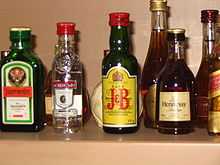Kirsch

A kirschwasser (/ˈkɪərʃvɑːsər/ KEERSH-vahs-ər; German: [ˈkɪɐ̯ʃvasɐ], German for “cherry water”) or kirsch is a clear, colorless fruit brandy traditionally made from double distillation of morello cherries, a dark-colored cultivar of the sour cherry. However, it is now also made from other kinds of cherries. The cherries are fermented complete (that is, including their stones).[1] Unlike cherry liqueurs and so-called “cherry brandies”, kirschwasser is not sweet.
The best kirschwassers have a refined taste with subtle flavors of cherry and a slight bitter-almond taste that derives from the stones.
Serving
Kirschwasser is usually drunk neat. It is traditionally served cold in a very small glass and is taken as an apéritif. However, people in the German-speaking region where kirschwasser originated usually serve it after dinner, as a digestif.
Kirschwasser is used in some cocktails, such as the Ladyfinger and the Florida.
High-quality kirschwasser may be served at room temperature, warmed by the hands as with brandy.
Origin and production

Because morellos were originally grown in the Black Forest regions of Germany, kirschwasser is believed to have originated there.
Kirschwasser is colourless because it is either not aged in wood or is aged in barrels made of ash. It may have been aged in paraffin-lined wood barrels or in earthenware vessels.[1]
In France and in English-speaking countries, clear fruit brandies are known as eaux de vie. The European Union sets a minimum of 37.5% ABV (75 proof) for products of this kind; kirschwasser typically has an alcohol content of 40%–50% ABV (80–100 proof). About 10 kilograms (22 pounds) of cherries go into the making of a 750 ml bottle of kirschwasser.
Food

Kirsch is sometimes used in Swiss fondue and in some cakes,[2] such as the Zuger Kirschtorte. It is also commonly used in the dessert cherries jubilee.
It is used in traditional German Schwarzwälder Kirschtorte (Black Forest cake, which is believed to have originated in the 16th century) and in other cakes—for example in Gugelhupf cake.
Kirsch can also be used in the filling of chocolates. A typical kirsch chocolate consists of no more than one milliliter of kirsch, surrounded by milk or (more usually) dark chocolate with a film of hard sugar between the two parts. The hard sugar acts as an impermeable casing for the liquid content and also compensates for the lack of sweetness that is typical of kirsch. Swiss chocolatiers Lindt & Sprüngli and Camille Bloch, among others, manufacture these kirsch chocolates.
See also
- Black Forest cake
- Cherries Jubilee
- Distilled beverage
- Eau-de-vie
- Fruit brandy
- Himbeergeist
- Liqueur
- Schnapps
- Culinary Heritage of Switzerland
References
- ↑ 1.0 1.1 Lichine, Alexis. Alexis Lichine’s New Encyclopedia of Wines & Spirits (New York: Alfred A. Knopf, 1987), 292.
- ↑ Use of kirsch in a traditional Swiss cake
External links
| Wikimedia Commons has media related to Kirschwasser. |
- Kirsch in the online Culinary Heritage of Switzerland database.


